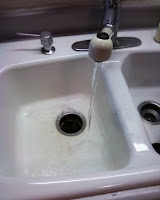
Time to change that old vinyl flooring to some new updated ceramic tile!
First, we need to scrape all of the old flooring off.

We have Henry's Adhesive Remover to apply to the concrete to help loosen up the glue from the vinyl flooring.
begin to scrape the glue off.
Now that we got all the glue off we're going to sweep all of the little debris off.

Now we're ready to lay out the tile. Basically, we are going to start from the middle of the room and work our way out. We're going to snap a square line down the center of the room. By doing this it makes everything symmetrical.

Now that our layout is all ready we're going to mix our adhesive. Make sure to follow directions carefully. You don't want it too runny and you don't want it too dry. I think the best way to explain it would be the consistency of cake batter.

With a drill motor and a beater you can be sure that it is well mixed. Watch out for any dry powder still in the bucket!

Now with our line snapped and our adhesive mixed we're going to lay our first row of tile right on the line. I'm also using a laser on top of the line so that in case I go over the snapped line with the adhesive I am still able to see the beam of light from the laser. When spreading the adhesive...don't forget your notch trowel. We're using 1/2" knotch trowel with 1/4" spacers.
Now that our tiles are set we want to vacuum out the grout lines to remove any debris and excess adhesive.

We are using a sand texture grout. Again, be sure to read all directions. Just as with the adhesive, you don't want it too runny or too thick. It should be similar to the consistency of the adhesive.

The tools needed for this step are our grout tool, our grout, a clean sponge and clean water. Apply the grout in the space in between the tiles. Wipe it with a DAMP sponge. Don't soak the sponge. Use a wax on...wax off kind of motion. (man, I love that Karate Kid). Wax on the grout into the space and wax off the grout onto your sponge leaving grout only in between the tiles.

We are using a sand texture grout. Again, be sure to read all directions. Just as with the adhesive, you don't want it too runny or too thick. It should be similar to the consistency of the adhesive.

The tools needed for this step are our grout tool, our grout, a clean sponge and clean water. Apply the grout in the space in between the tiles. Wipe it with a DAMP sponge. Don't soak the sponge. Use a wax on...wax off kind of motion. (man, I love that Karate Kid). Wax on the grout into the space and wax off the grout onto your sponge leaving grout only in between the tiles.
With our grout all finished and everything cleaned up, allow 48 hours to pass so that the grout can cure. Then you're going to add a grout sealer.

This is the grout sealer that we're going to be using. If you don't apply this and you spill a cup of coffee or some Kool-Aid it will stain your grout lines and even the tile. It is a must that we apply the grout sealer. Spray the grout sealer all over your tile. Don't be afraid that you'll spray too much. The more the better. Let it sit for 5-10 minutes so that it can soak in the grout and tile. Then wipe it off with a nice clean cloth. And you're done!









 Now with no power going to the garbage disposal we need to unhook all of the hoses and traps from the garbarge disposal.
Now with no power going to the garbage disposal we need to unhook all of the hoses and traps from the garbarge disposal. 
































